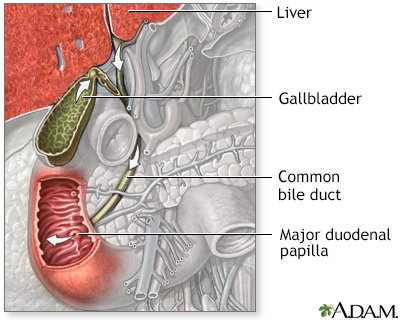Bile duct obstruction
Biliary obstruction
Bile duct obstruction is a blockage in the tubes that carry bile from the liver to the gallbladder and small intestine.

The esophagus, stomach, large and small intestine, aided by the liver, gallbladder and pancreas convert the nutritive components of food into energy and break down the non-nutritive components into waste to be excreted.

Endocrine glands release hormones (chemical messengers) into the bloodstream to be transported to various organs and tissues throughout the body. For instance, the pancreas secretes insulin, which allows the body to regulate levels of sugar in the blood. The thyroid gets instructions from the pituitary to secrete hormones which determine the rate of metabolism in the body (the more hormone in the bloodstream, the faster the chemical activity; the less hormone, the slower the activity).

The biliary system is comprised of the organs and duct system that create, transport, store and release bile into the duodenum for digestion. Includes the liver, gallbladder and bile ducts (named the cystic, hepatic, common, and pancreatic duct).

Bile is a digestive fluid secreted by the liver and stored in the gallbladder which normally is released into the duodenum portion of the small intestine through the sphincter of Oddi. Bile, released after a meal containing fats, aids in absorption and digestion of the fat.
Causes
Bile is a liquid released by the liver. It contains cholesterol, bile salts, and waste products such as bilirubin. Bile salts help your body break down (digest) fats. Bile passes out of the liver through the bile ducts and is stored in the gallbladder. After a meal, it is released into the small intestine.
When the bile ducts become blocked, bile builds up in the liver, and jaundice (yellow color of the skin) develops due to the increasing level of bilirubin in the blood.
The possible causes of a blocked bile duct include:
- Cysts of the common bile duct
- Enlarged lymph nodes in the porta hepatis (an area on the underside of the liver through which the bile duct passes)
- Gallstones
- Inflammation of the bile ducts
- Narrowing of the bile ducts from scarring
- Injury of a bile duct from gallbladder surgery
- Tumors of the bile ducts or pancreas
- Tumors that have spread to the biliary system
- Liver and bile duct worms (flukes)
The risk factors for a blocked bile duct include:
- A history of gallstones, chronic pancreatitis, or pancreatic cancer
- Injury to the abdominal area
- Recent biliary surgery
- Recent biliary cancer (such as bile duct cancer)
The blockage can also be caused by infections. This is more common in people with weakened immune systems.
Symptoms
Symptoms may include:
- Abdominal pain in the upper right side
- Dark urine
- Fever
- Itching
- Jaundice (yellow skin color)
- Nausea and vomiting
- Clay-colored or pale stools
Exams and Tests
Your health care provider will examine you and feel your belly.
The following blood test results could be due to a possible bile duct blockage:
- Increased bilirubin level
- Increased alkaline phosphatase level
- Increased GGT enzyme level
- Increased liver enzymes
The following tests may be used to investigate a possible blocked bile duct:
- Abdominal ultrasound
- Abdominal CT scan
- Endoscopic retrograde cholangiopancreatography (ERCP)
- Percutaneous transhepatic cholangiogram (PTCA)
- Magnetic resonance cholangiopancreatography (MRCP)
- Endoscopic ultrasound (EUS)
A blocked bile duct may also alter the results of the following tests:
- Amylase blood test
- Gallbladder radionuclide scan
- Lipase blood test
- Prothrombin time (PT)
- Urine bilirubin
Treatment
The goal of treatment is to relieve the blockage. Stones may be removed using an endoscope during an ERCP.
In some cases, surgery is required to bypass the blockage. The gallbladder will usually be surgically removed if the blockage is caused by gallstones. Your provider may prescribe antibiotics if an infection is suspected.
If the blockage is caused by cancer, the duct may need to be widened. This procedure is called endoscopic or percutaneous (through the skin next to the liver) dilation. A tube (stent or drain) may need to be placed to allow drainage.
Outlook (Prognosis)
If the blockage is not corrected, it can lead to life-threatening infection and a dangerous buildup of bilirubin.
If the blockage lasts a long time, chronic
Possible Complications
Left untreated, the possible complications include infections,
When to Contact a Medical Professional
Contact your provider if you:
- Notice a change in the color of your urine and stools
- Develop jaundice
- Have abdominal pain that doesn't go away or keeps recurring
Prevention
Be aware of any risk factors you have, so that you can get prompt diagnosis and treatment if a bile duct becomes blocked. The blockage itself may not be preventable.
References
Fogel EL, Sherman S. Diseases of the gallbladder and bile ducts. In: Goldman L, Cooney KA, eds. Goldman-Cecil Medicine. 27th ed. Philadelphia, PA: Elsevier; 2024:chap 141.
Lidofsky SD. Jaundice. In: Feldman M, Friedman LS, Brandt LJ, eds. Sleisenger and Fordtran's Gastrointestinal and Liver Disease. 11th ed. Philadelphia, PA: Elsevier; 2021:chap 21.
Version Info
Last reviewed on: 6/11/2024
Reviewed by: Jenifer K. Lehrer, MD, Department of Gastroenterology, Aria - Jefferson Health Torresdale, Jefferson Digestive Diseases Network, Philadelphia, PA. Review provided by VeriMed Healthcare Network. Also reviewed by David C. Dugdale, MD, Medical Director, Brenda Conaway, Editorial Director, and the A.D.A.M. Editorial team.
